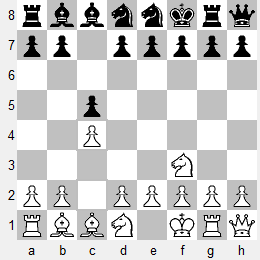The move that cries out to be played is 2...O-O. Castling O-O-O isn't going to be possible anytime soon, and it is hard to see where the Black King will find shelter elsewhere. The problem of King safety is intertwined with the problems of developing the Queen and g-Rook. It's easy to imagine where the minor pieces will be developed, but not at all easy for the King and major pieces.

I had two problems with 2...O-O. The first problem was the attack 3.g4 and 4.h4. After a single move forward, the Pawns backed by their own Rook and Queen already present a real menace. The second problem was the development 3.b3 and 4.Bb2. The Bishops on the a1-h8 and b1-h7 diagonals, although not presenting any immediate threat, will be raking Black's King position for a long time to come.
I decided that it was better to delay the castling decision for as long as possible, preferably waiting until White has shown his own hand. I finally played 2...b6, a natural move that opposes the light-squared Bishop against the Queen on the a8-h1 diagonal.
One advantage to thinking deeply about castling O-O was not having to revisit the decision over the next few moves. White castled O-O on the 11th move and Black followed suit on the 12th, confident that the King would not be overwhelmed. Castling on the first or second move is always an attractive option in chess960, but that doesn't mean it's a good one.

1 comment:
Castling differences in chess960-FRC is one of the two most fascinating contrasts with traditional chess1 (the other being the many differences in how to fight for the center).
In the FRC context, "Castling" is a single word that represents multiple issues that are fundamental to strong chess play.
"How shall I design my king fort for safety?"
...is just one inseparable side of a many-sided dice which necessarily interacts with questions such as....
"How shall I develop my pieces to ensure they are coordinated and are fighting for the center?".
These questions sets are more difficult to answer in most chess960 setups than they are in chess1.
I think this extra difficulty is one reason why some chess players have an initially negative reaction to FRC when they try it.
Yet it is that higher level of difficulty that indicates the riches of general chess that are hidden from us by our traditional exclude-all-others attitude about start positions.
Yes it is easy and comfortable to have all our knights start on the squares that just happen to make N-B3 the standard move, but there could be so much more to opening theory.
We should pick one nontraditional setup and reuse it frequently, until lots of opening systems and variations have been analyzed, recorded, published, and tested in rated tournament play. That would take a couple decades.
Annointing a second stable setup would be better than rolling dice to determine the start position moments before every FRC game; because that approach prevents growth.
** Discard the 'Random' from Fischer Random Chess!
Thanks.
GeneM
Post a Comment